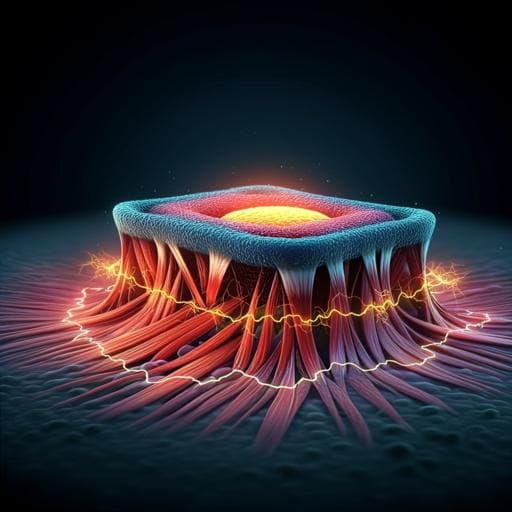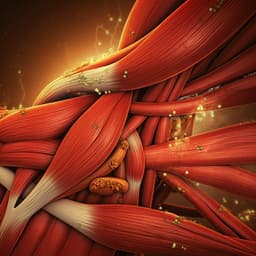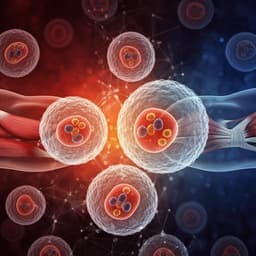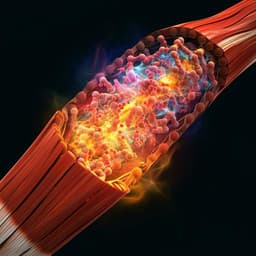
Medicine and Health
Matrigel 3D bioprinting of contractile human skeletal muscle models recapitulating exercise and pharmacological responses
A. A. Reyes-furrer, S. D. Andrade, et al.
Discover how researchers Angela Alave Reyes-Furrer and colleagues have innovated 3D human skeletal muscle models through advanced bioprinting techniques. Their miniature models show remarkable contractile abilities, paving the way for novel drug development in combating muscle wasting diseases.
~3 min • Beginner • English
Introduction
The study addresses the need for more translatable preclinical models in drug discovery, particularly for muscle-wasting diseases lacking effective therapeutics. Traditional 2D cultures of human skeletal muscle precursor cells enable myotube formation but cannot assess core muscle functions such as contractile force and fatigue. Existing 3D human skeletal muscle models have shown pharmacological relevance but lacked robustness for routine screening. The authors previously established an automated 24-well 3D bioprinting platform using microvalve-based drop-on-demand (DOD) printing; however, differentiation and contractility were poor with a metabolically inert PEG-based bioink. Recognizing Matrigel’s widespread use as a basement membrane extract that supports differentiation, the authors hypothesized that DOD printing of primary human myoblasts in pure Matrigel, enabled by a cooled printhead to prevent premature gelling, could produce functional, contractile 3D skeletal muscle microtissues suitable for in vitro exercise and pharmacology studies.
Literature Review
Prior work established 2D skeletal muscle cultures for identifying modulators of muscle mass (e.g., myostatin pathway blockers), but these do not capture contractile function. Multiple 3D skeletal muscle models have been developed and can reflect clinical pharmacology, yet have not proven reliable or robust enough for drug screening. The authors’ earlier multiwell DOD bioprinting approach combined cell jetting with a PEG-based photo-polymerizable bioink but yielded poor maturation and minimal contractility. Matrigel is widely used in 3D culture systems and organoids for its biological cues and with fibrin in skeletal muscle models, but it has rarely been used as a standalone bioink due to thermal gelling challenges; most reports use extrusion printing with temperature-controlled enclosures or blends with alginate/agarose, which can impair differentiation. Microvalve-based DOD printing offers precise spatial cell deposition that surpasses conventional micromolding for engineering complex tissues.
Methodology
Bioprinting platform and cooling: A water-circulating cooling system with insulated tubing and a temperature-controlled water bath regulated the printhead cartridges at 7 °C. Temperature at the printhead was 7.3 ± 0.14 °C, and at the microvalve orifice 13.4 ± 0.22 °C, stable for over 2 hours.
Matrigel rheology and selection: Two Matrigel batches (8.1 and 9.5 mg/mL total protein) were assessed. 50 µL drops were tested after 30 min at 37 °C; gels above 3 mg/mL solidified, while ≥4 mg/mL maintained shape upon lift; undiluted 8–10 mg/mL provided optimal printability and post-print gelling.
Cells and bioink: Primary human skeletal muscle-derived cells (COOK MyoSite; donors aged 17, 19, 40) were expanded to ~60% confluence. Cells were harvested and resuspended on ice in pure Matrigel (8–10 mg/mL) at 2 × 10^7 cells/mL.
3D bioprinting: Dumbbell-shaped 4-layer constructs were DOD-printed onto 0.8% agarose in 24-well plates using 150 µm orifice microvalves. Parameters: 100 µm stroke, 200 µs opening time, 0.04 mm dosing distance, 600 hPa pressure. After 1 h at 37 °C (gelling), two flexible posts (≈1 cm length, 0.9 mm diameter pipette tip segments) were inserted at construct ends in the agarose to provide attachment points. Microvalves were rigorously cleaned post-printing (hot water, ethanol, and air cycles) to prevent clogging.
Differentiation: Constructs were maintained 24 h in growth medium, then switched to differentiation medium (phenol red-free DMEM high glucose, 2% hi horse serum, 1% FBS, 1% chicken embryo extract, 1% sodium pyruvate, 1% L-glutamine, 50 µg/mL gentamycin) at 37 °C with 7.5% CO2; medium was changed every 2–3 days. 2D control cultures were differentiated similarly.
Histology and gene expression: qPCR for myogenesis markers (Myf5, MyoD, Myog), structural genes (Actn2, Myh1-3, Myh7, Myh8) normalized to 18S, GAPDH, TBP, β2M. Whole-mount immunofluorescence (Myh, α-actinin, F-actin) and paraffin cross-sections were performed.
Electrical pulse stimulation (EPS) and exercise protocol: A custom 24-well EPS system with U-shaped platinum electrodes oriented parallel to tissue axis enabled stimulation well-by-well/column-by-column. Exercise protocol: 300 ms trains at 25 Hz delivered every second for 3 h. Pharmacological blockade included blebbistatin (myosin inhibitor) and tetrodotoxin (TTX, 1 µM) to assess excitation-contraction coupling.
Force measurement: Constructs were mounted on an organ bath force transducer for isometric force recording. Supramaximal stimulation determined by increasing current with 2 ms single twitch pulses; 400 mA was used subsequently. Effects of model elongation (20–40 µm), pulse duration (0.5–2 ms), and stimulation patterns (single vs multiple pulses) were evaluated.
Pharmacology: Acute effects of caffeine (10 mM) and Tirasemtiv (CK-2017357; 10–30 µM, typically 20 µM) on EPS-induced force were assessed. Solvent controls (0.2% DMSO) were included. Outcomes included peak force, contraction width at 50% amplitude (width50), and area under the curve (AUC).
Key Findings
- Reliable DOD printing of cell-laden pure Matrigel was achieved using a cooled printhead: printhead 7.3 ± 0.14 °C; microvalve orifice 13.4 ± 0.22 °C; stable >2 h.
- Matrigel gelling and printability: ≥3 mg/mL solidified at 37 °C; ≥4 mg/mL maintained shape upon lift. Undiluted 8–10 mg/mL provided optimal shape retention and printability. Droplet diameter decreased by ~30% after 60 min post-cartridge loading but print quality remained reproducible for up to 90 min.
- Tissue formation: With flexible posts, models condensed longitudinally and maintained attachments up to ≥3 weeks (donors 19 and 40). Without posts (Matrigel overlay), constructs shrank in length and showed reduced width condensation, indicating the necessity of tensile anchoring for aligned myofiber formation.
- Differentiation markers: In 3D models, Myf5 decreased with differentiation, while MyoD/Myog increased more strongly and sustained compared with 2D. Structural genes (Actn2, Myh family) were higher and more sustained in 3D; donor 19 showed particularly robust expression. Fiber typing indicated predominantly slow/embryonal types: Myh7 highest, followed by Myh3 and Myh8; Myh1/2 were marginal.
- Histology: 3D models formed aligned, multinucleated, striated myofibers by day 6–10, with uniform distribution across cross-sections (~1–1.5 mm width, ~200–300 µm height). Models lifted ~1 mm from agarose and displayed spontaneous contractions.
- Physiological contractility: EPS produced controlled twitches; contractions were blocked by blebbistatin and TTX (1 µM), confirming physiological excitation-contraction coupling via Na+ channel-dependent action potentials.
- Exercise responses: 3 h high-impact EPS induced Akt phosphorylation ~6-fold in 16-day models (Thr308 and Ser473) and upregulated IL-6 mRNA (5.7-fold at day 19; significant at days 12, 16, 19), validating hypertrophy/myokine responses.
- Force characteristics: Peak twitch force increased with current and plateaued ~120 µN at ~300 mA; 400 mA used for supramaximal stimulation. Multiple-pulse trains increased peak force ~3-fold versus single pulses. Shorter pulse durations reduced peak force relative to 2 ms (1 ms: −9%; 0.5 ms: −21%). TTX fully abolished 1 ms EPS contractions.
- Pharmacology: Caffeine 10 mM increased peak force by +43.4% and markedly prolonged contraction (+413% width50; +693% AUC). Tirasemtiv 20 µM increased peak force by +46.3%, width50 by +60.8%, and AUC by +148%; EC50 ~10 µM with maximal effect at 20 µM. DMSO control caused a small peak force decrease (−9.2%) with no significant effects on duration metrics.
Discussion
The authors demonstrate that microvalve-based DOD 3D bioprinting of primary human skeletal muscle cells suspended in pure Matrigel, enabled by an integrated cooling system, yields reproducible, contractile microtissues in a 24-well plate format. Pure Matrigel, a basement membrane-rich matrix, provided a permissive environment for robust myofiber differentiation, overcoming previous limitations observed with synthetic PEG-based inks. Flexible anchoring posts matched the developing tensile forces, supporting alignment, compaction, and maturation of myofibers, whereas unanchored constructs failed to form functional fibers, underscoring the importance of mechanical boundary conditions. The custom EPS platform elicited physiological excitation via Na+ channel-dependent action potentials and enabled an in vitro exercise paradigm that activated Akt signaling and induced IL-6, aligning with known in vivo exercise responses. Pharmacological validation with caffeine and the fast skeletal troponin activator Tirasemtiv acutely enhanced contractile performance, closely mirroring reported effects in animal muscle preparations. Together, these findings establish a human skeletal muscle microphysiological system that captures structural maturation, functional contractility, exercise-like signaling, and pharmacological responsiveness, supporting its utility for mechanism studies and medium-throughput drug screening against muscle-wasting disorders.
Conclusion
This work introduces a robust, automated DOD 3D bioprinting approach using pure Matrigel to generate aligned, contractile human skeletal muscle microtissues in 24-well plates. The system reliably reproduces physiological excitation-contraction coupling, exercise-induced Akt activation and IL-6 expression, and acute force potentiation by caffeine and Tirasemtiv. These advances overcome prior issues with non-permissive bioinks and insufficient mechanical support, delivering a functional human muscle MPS suitable for pharmacological screening. Future directions include standardizing and engineering micro-posts with defined mechanical properties, integrating additional cell types (e.g., motor neurons or vasculature) for higher physiological complexity, refining maturation toward adult fast fiber phenotypes, and adapting the platform to higher-density formats for increased throughput.
Limitations
- Bioink source: Matrigel is a mouse tumor-derived basement membrane extract, limiting clinical translatability and potentially introducing batch-to-batch variability; authors recommend batch testing.
- Fiber maturity and composition: Models predominantly exhibited slow/embryonal myosin isoforms and signs of immaturity (e.g., caffeine-prolonged contractions), indicating incomplete adult-like maturation and limited fast fiber representation.
- Mechanical fixtures: Flexible posts were fashioned from pipette tips, lacking standardized, tunable mechanical properties; rupture still occurred in some donors, and overall tissue sturdiness was lower than native muscle.
- Throughput and format: Demonstrated in 24-well plates; while suitable for medium throughput, higher-density formats were not shown.
- Thermal control: Microvalve orifice temperature was higher than the cartridge setpoint; inclusion of the microvalve within the cooling jacket could further stabilize printing.
- Donor variability: Survival and maturation differed across donors (e.g., earlier rupture in the 17-year-old donor), which may affect reproducibility and generalizability across cell sources.
Related Publications
Explore these studies to deepen your understanding of the subject.







